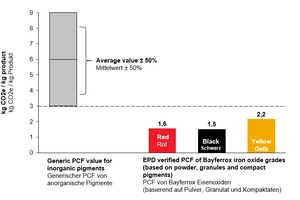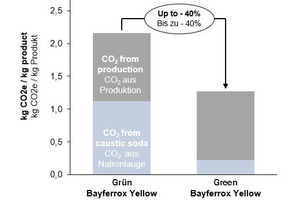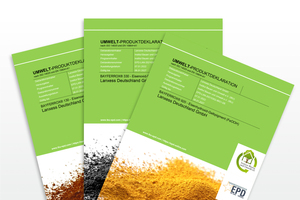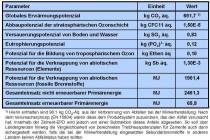EPDs for the realization of low-emission
product strategies along the value chain
Environmental product declarations (EPDs) have become a proven means of communicating the environmental footprints of construction products such as concrete materials. They provide the basis for determining consistent life cycle assessments for complete buildings. This trend will continue to grow in the future.
Environmental product declarations (EPDs) have become a proven means of communicating the environmental footprints of construction products such as concrete materials. They provide the basis for determining consistent life cycle assessments for complete buildings. This trend will continue to grow in the future because many certification systems for sustainable construction reward the use of building products with EPDs - such as those from the German Sustainable Building Council (Deutschen Gesellschaft für Nachhaltiges Bauen, DGNB).
All of this was expressed in an ever-increasing supply of EPDs. Around 1500 EPDs from around 500 declaration holders are currently published by the Institut für Bauen und Umwelt e.V. (IBU) alone, for example - and the trend is rising. Harmonization at the European level is ensured by the cooperation of local EPD program operators within the framework of the EcoPlatform initiative.
Verified environmental product declarations for climate- and resource-friendly construction
An EPD is based on independently verified data taken from life-cycle assessments, life-cycle inventory analyses, or information modules that comply amongst other with the EN 15804 and DIN EN ISO 14040 standard series. This covers information such as use of resources including energy, water, and renewable resources as well as emissions into the air, water, and ground. An EPD conveys verifiable and non-misleading environmental information about products. One main purpose of this is to provide comparable and reliable data for evaluating the environmental impact of construction projects.
This has various benefits for manufacturers of concrete products, chief among them transparency, which manufacturers are increasingly making a key pillar of their sustainability strategies. EPDs are a recognized means of documenting and demonstrating this transparency, giving building material manufacturers a way of providing key data for calculating the life-cycle assessments of buildings and evaluating the environmental benefits of construction products in the context of a specific building on the basis of scientific criteria. Another benefit is market access, particularly in projects that are seeking to obtain a building certification where availability of EPDs is now an important criterion. What’s more, their importance is growing. The Proposal for a New Construction Products Regulation published at the end of March 2022 stipulates that in the future, most of the performance indicators that are required in EPDs will also be included in the declaration of performance, making the EPD a kind of ticket of admission into the European market.
In recent times, a further benefit has come to building material manufacturers’ attention, and that is value chain optimization. Published EPDs contain only results that are highly aggregated. When they are prepared, it is often the first time that many companies realize what a dominant influence manufacturing processes and the raw materials used can have on the environmental footprints of their own products. Energy-intensive raw materials, for example, can feature to a larger-than-expected extent in the environmental footprint of a product for the construction industry. So it is beneficial if the purchased raw material products come with their own EPDs as well.
Not only does this make the accuracy of the results much greater; it also means that the data consolidated in the information modules is often much more up-to-date as well compared to generic data. Last but not least, using product-specific EPDs for raw materials is a way of showing a manufacturer’s efforts to reduce the footprints of its products in the first place.
Creating the prerequisite for sustainable buildings
For these reasons, the demand for detailed LCA data across the entire supply chain is expected to grow exponentially. On the one hand, data users such as planners and auditors are placing ever-greater requirements on data quality, including for building sustainability certification, for instance. On the other hand, it is becoming apparent that legislators, too, have recognized the importance of suppliers. For example, the Proposal for the New European Construction Products Regulation already not only contains provisions to report verified data on the environmental footprint for manufacturers of construction products, but also their suppliers. While in general a direct comparison of different products by their EPDs is not encouraged for a number of reasons, in the case of raw materials used for the production of construction materials it can be meaningful provided that both products are functionally equivalent in every aspect.
This is particularly true in the case of iron oxide pigments being used for the coloration of concrete products. As the first raw-material supplier of synthetic iron oxide pigments, Lanxess has introduced EPDs for selected iron oxide products in 2022 and will soon expand this offering for its entire range of its red, yellow and black pigments manufactured at its German site in Krefeld-Uerdingen. The company shares the view that all raw materials used to manufacture construction materials will require an EPD verification in the medium term because the information on the environmental impact of products in EPDs, which is based on uniform assessment parameters, can give raw material manufacturers that continuously invest in environmentally friendly production processes a competitive advantage.
At Lanxess, the use of energy-efficient processes is part of the business strategy. The chemical synthesis of iron oxide pigments, for example, is inherently energy-intensive. Lanxess has drawn up a road map for the future to reduce the CO2 emissions at the Uerdingen site by around 50 percent between now and 2030 using new technologies and by switching to green electricity.
A comparison is worthwhile
In the past, Lanxess believed that such technical efforts and, at times, extremely costly investments were too seldomly factored into purchase decisions. But now there is a clear trend taking off in a different direction, with the majority of companies in construction industry now pushing to reduce emissions throughout the entire supply chain. EPDs for raw materials have the potential to act as a basis for a fair comparison and allow emissions to be lowered effectively along the value chain. But ultimately, this can work only if the raw materials used are selected with regard to their environmental profiles based on the best supplier principle. EPDs offer a credible and standardized basis for comparing products from differing raw material suppliers.
Here is an example: An EPD provides a holistic assessment of products with regard to all environmental impacts. Currently, there is a significant focus on the product carbon footprint (PCF). Lanxess iron oxide pigments, for which there is an EPD available, have a PCF of around 1.5 to 2.5 kilograms of CO2 equivalent (CO2e) per kilogram of product (figure 1). This figure can be compared with that of alternative products only if there is an EPD available. If not, then generic figures have to be used that often constitute a non-specific mean value and can be prone to error. For inorganic pigments in general, this mean value was quoted in a publication by an European association of the mineral paint industry a few years ago as being roughly 6 kg of CO2 equivalent per kilogram of product ±50 % – based on the manufacturing process. The customer can now decide by direct comparison what economic value to ascribe to the product with the better environmental footprint.
Moreover, Lanxess is taking targeted action to continuously improve the environmental footprint of its pigment products. A current example of the sustainability efforts is the recently decided measure to produce micronized yellow pigments of the Bayferrox range in the future also using „green“ caustic soda. The supplier of this important raw material produces the lye on the basis of renewable energies. It is used in the so-called precipitation process, which produces very high-quality yellow pigments with special properties such as high color strength and heat stability. Thanks to the „green“ raw material, CO2 emissions in the manufacture of these product groups are reduced by up to 40 percent per kilogram of pigment (figure 2). Because of their particular sustainability, Lanxess intends to verify the environmental profile of these new yellow pigment product group in a separate EPD.
CONTACT
Lanxess Deutschland GmbH
Kennedyplatz 1
50569 Cologne/Germany
+49 221 8885-0














